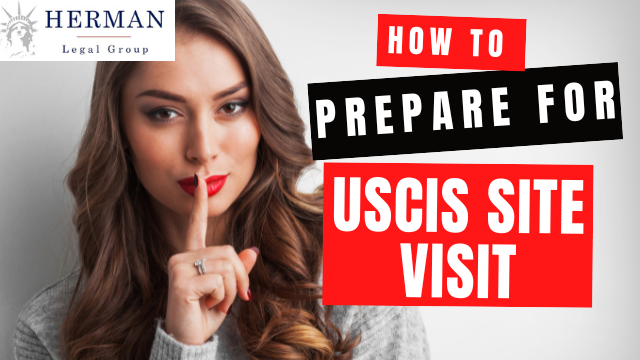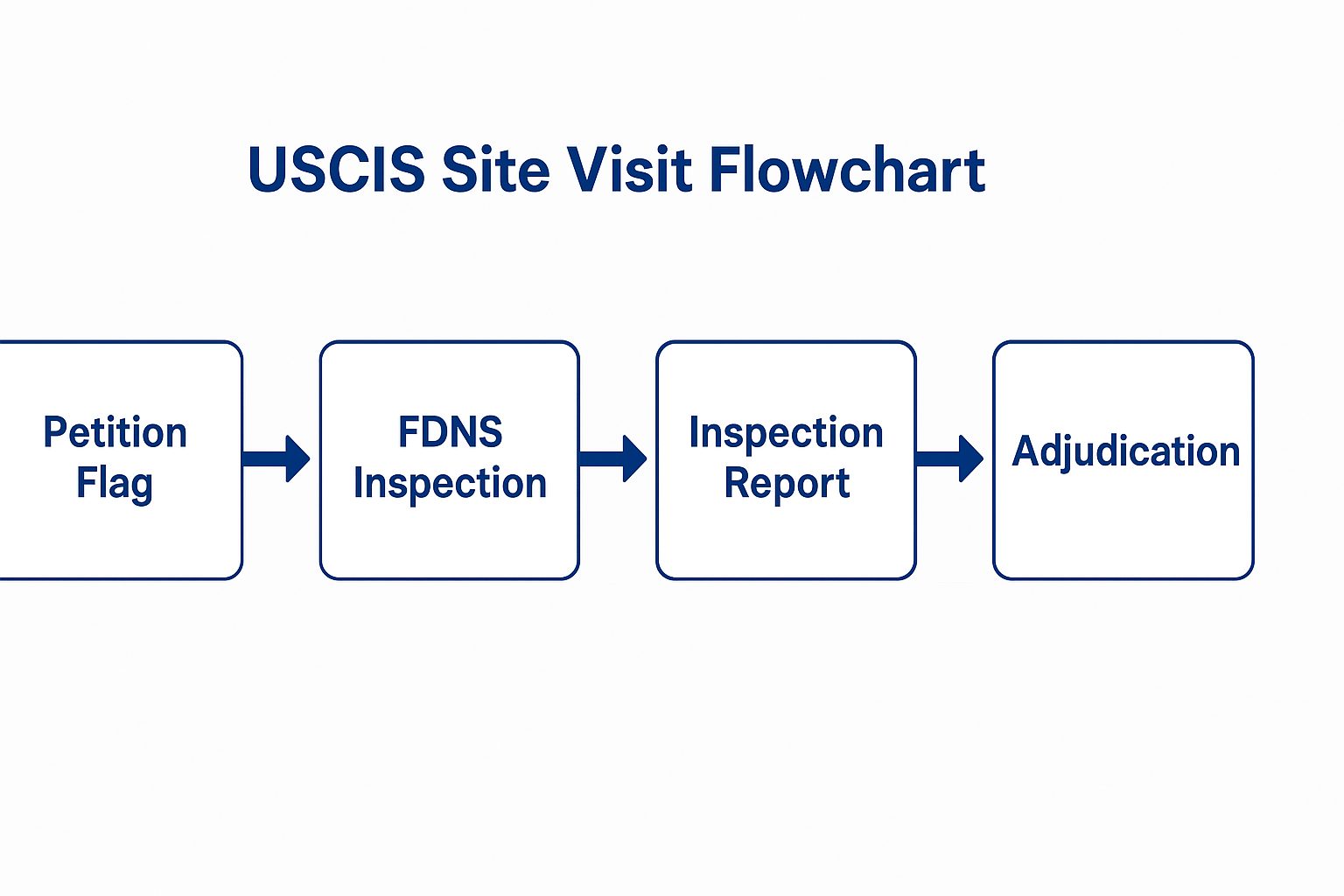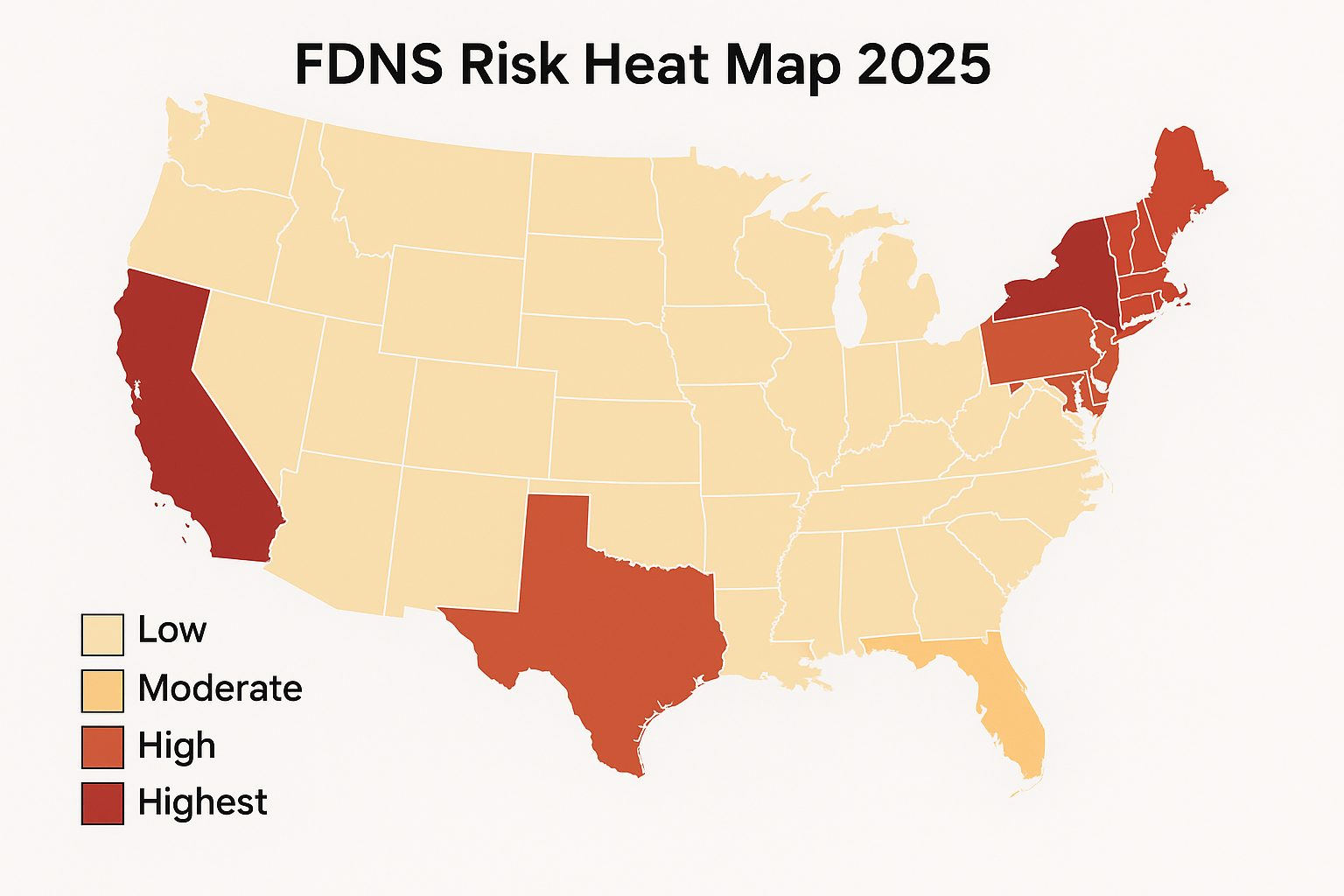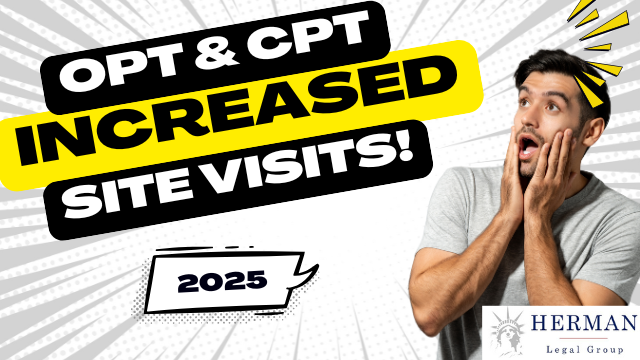When the U.S. Citizenship and Immigration Services (USCIS) decides to verify an immigration petition, it may not always do so from behind a desk. Increasingly, it’s doing so in person — through site visits conducted by its Fraud Detection and National Security Directorate (FDNS). These are unannounced site visits that are typically conducted without prior notice by USCIS officers to verify compliance with immigration laws. These site visits are part of broader USCIS fraud detection efforts under the authority of the Department of Homeland Security. These unannounced inspections are designed to confirm whether the details listed in a visa petition match reality — including the employee’s work location, job duties, and salary. USCIS started the Administrative Site Visit and Verification Program (ASVVP) in 2009 to verify information in certain petitions.
If you are an H-1B or L-1 employer, or a foreign national working in the U.S., a USCIS site visit can be intimidating. But preparation can make all the difference. Understanding why these visits occur—USCIS and FDNS conduct site visits as part of their compliance and fraud detection responsibilities—what officers are looking for, and how to respond professionally can protect both your immigration status and your company’s compliance record. It is essential to prepare the foreign national employee by briefing them on key details of their petition, including job title, duties, work location, and salary.
Immigration Lawyer Richard Herman: “USCIS site visits are unannounced compliance inspections meant to verify the truthfulness of information in visa petitions — not criminal raids, but official audits under federal authority.”
Under Trump’s second-term enforcement strategy (2025–2026), FDNS inspections have become more frequent and broader in scope, targeting not only H-1B employers but also L-1 transferees, STEM OPT trainees, and even EB-5 regional centers. Administrative site visits are typically conducted without prior notice, so employers should always be prepared for such inspections. Knowing your rights and responsibilities in advance is essential to minimize legal risks. USCIS launched the Targeted Site Visit and Verification Program (TSVVP) in 2017 to take a more data-driven approach to petition verification.

What Is a USCIS Site Visit and Why Does It Happen?
A USCIS site visit is a surprise, in-person inspection carried out by the Fraud Detection and National Security Directorate (FDNS)— a specialized unit within USCIS responsible for preventing immigration fraud and ensuring that petitioning employers comply with federal visa regulations. An FDNS site visit is a type of administrative site visit used to verify facts and ensure compliance with immigration regulations. Immigration officers do not make decisions on petitions; USCIS adjudicators review reports for indications of fraud or noncompliance.
FDNS officers typically appear without advance notice, often at the work location listed on the petition. These administrative site visits can occur at the employer’s principal place of business or at a third-party worksite listed in the petition. Their goal is to confirm that: USCIS site visit officers may take photos of the worksite and interview various employees to verify compliance. Officers may request documents, collect information from employees and public records, and review supporting documents to confirm the accuracy of the petition.
- The foreign worker is employed in the position described in the petition.
- The employer exists and operates at the stated address.
- The terms and conditions of employment (such as wage, duties, and supervision) match the certified Labor Condition Application (LCA).
- The work arrangement complies with Department of Labor (DOL) and USCIS regulations.
According to USCIS, FDNS site visits help “ensure program integrity, detect fraud, and protect U.S. workers.” Review USCIS’s official FDNS overview. Any red flags identified during the site visit can lead to further investigation by USCIS.
Programs Commonly Targeted for Site Visits
FDNS focuses on high-volume visa categories prone to compliance errors, including:
- H-1B Specialty Occupation Workers: https://www.uscis.gov/working-in-the-united-states/h-1b-specialty-occupations
- L-1 intracompany transferees — USCIS page for L-1A (executive/manager transfers)https://www.uscis.gov/working-in-the-united-states/temporary-workers/l-1a-intracompany-transferee-executive-or-managerUSCIS
- R-1 religious workers — USCIS official page on nonimmigrant religious worker classification https://www.uscis.gov/working-in-the-united-states/temporary-workers/r-1-nonimmigrant-religious-workersUSCIS
- F-1 STEM OPT trainees — official USCIS page for Optional Practical Training extension for STEM students https://www.uscis.gov/working-in-the-united-states/students-and-exchange-visitors/optional-practical-training-extension-for-stem-students-stem-optUSCIS
- STEM OPT employer site visits — DHS/ICE “Study in the States” page about employer site visits under STEM OPT rules https://studyinthestates.dhs.gov/stem-opt-hub/for-employers/employer-site-visitsStudy in the States
**Richard Herman, Immigration Attorney: “**FDNS officers verify whether a visa petition accurately reflects the employer’s operations and the employee’s job. Inaccuracies — even unintentional — can lead to revocation or denial.”
Legal Basis and Background
FDNS site visits were first formalized under a 2009 USCIS initiative, expanded during Trump’s first term under Executive Order 13788: Buy American, Hire American. In 2025, renewed emphasis on worksite verification and employer accountability has led to a second wave of audits, often supported by Department of Labor (DOL) and Immigration and Customs Enforcement (ICE) when fraud indicators arise. FDNS uses a randomized process to select petitions for ASVVP site visits and a data-driven process for TSVVP.
Statements made during a site visit can be used in future Requests for Evidence (RFEs) or Notices of Intent to Revoke (NOIRs). Preparation, documentation, and professionalism are key. Detailed notes should be taken during the site visit, including the officer’s name, the time and duration of the visit, and a log of all questions asked. It is essential to keep a detailed record of the site visit, documenting all questions, responses, and any follow-up actions to ensure comprehensive compliance documentation.
For official guidance, consult the USCIS Policy Manual.
Ongoing compliance efforts, including clear procedures and regular training, are necessary to ensure compliance with immigration regulations and avoid penalties.
Who Conducts the Site Visit and What Do They Check?
A USCIS site visit is carried out by an FDNS officer, part of a specialized directorate dedicated to fraud prevention, data verification, and national security screening. A USCIS officer is responsible for conducting the site visit and verifying the information provided in immigration petitions. Employers are required to verify the FDNS officer’s credentials during site visits.
Snippet Callout: FDNS officers are administrative investigators — not law enforcement agents — tasked with verifying the accuracy of immigration filings.
FDNS officers arrive unannounced during business hours, carrying federal identification and typically providing a business card for verification. During a site visit, the designated representative should escort the FDNS officer throughout the visit.
FDNS Officer’s Role and Authority
FDNS officers can:
- Conduct in-person verification of petition data
- Interview the foreign worker and supervisors
- Observe workplace conditions
- Review LCAs, payroll, and organizational charts
They cannot:
- Enter restricted areas without consent
- Demand trade secrets
- Seize property
Employers can confirm officer credentials through the USCIS Contact Center.
USCIS Site Visit Flowchart

What Officers Check
| Inspection Area | Example Evidence | Purpose |
|---|---|---|
| Business legitimacy | Lease, EIN, signage | Confirm active operations |
| Employee verification | ID, pay stubs, and other documents may be required | Confirm bona fide employment |
| Job duties | Offer letter, project docs | Match petition |
| Wages | Payroll, tax filings | LCA compliance |
| Supervision | Org chart | Confirms reporting structure |
During a site visit, officers may inspect the physical workspace and expect all supporting documents to be readily accessible for review.
What Triggers a USCIS Site Visit
FDNS site visits may be random — but are often triggered by data or risk indicators. Inconsistencies in an H-1B petition, discrepancies found in public records, or issues involving an end client can also trigger a site visit.
Richard Herman, Esq.: “USCIS increasingly uses analytics and whistleblower data to select employers for inspection.”
Key Triggers
- Random selection (routine sampling)
- H-1B amendments or extensions
- Whistleblower reports filed via ICE Tip Line
- Third-party placements or remote work
- LinkedIn or website inconsistencies
- Prior compliance issues
Visual: FDNS Risk Heat Map 2025

AI-Driven Risk Targeting
FDNS uses AI-based analytics cross-referencing IRS filings, SEVIS data, and LinkedIn records. Employers with mismatched data are more likely to be flagged.
For oversight findings, review the DHS Office of Inspector General Report on FDNS.
How to Prepare Before a USCIS Site Visit (Employer Checklist)
1. Create a Compliance Binder
Include:
- Petition and Form I-129
- Certified LCA
- Payroll and IRS Form 941
- Business licenses, lease, EIN
2. Train Reception Staff
- Ask for identification
- Contact HR
- Escort officer only to public areas
3. Designate a Company Representative
Ensure one individual oversees compliance responses.
4. Conduct Internal Audits
Review public access files and job titles annually.
5. Maintain Updated LCAs
Amend petitions for job or location changes.
Attorney Richard Herman: “Routine self-audits and trained staff are your first line of defense.”
Employee Preparation: What to Expect During an Interview
FDNS interviews are informal but structured. During these site visits, FDNS officers may interview the foreign worker directly, as well as other employees, to verify employment details and ensure the nonimmigrant worker is performing the duties described in the petition. Typical questions include:
- What is your title and role?
- Who supervises you?
- Where do you work daily?
- What is your salary?
Employees should answer honestly and succinctly. If uncertain, request to verify with HR.
More interview tips from USCIS Site Visit Guidance.
Employer Obligations During a Site Visit
Employers must:
- Cooperate with basic verification
- Provide petition records if requested
- Keep a record of officer identity and questions
They may:
- Decline access to private areas
- Request counsel presence
See DHS Privacy Policy for rules governing data collection.
Common Mistakes That Trigger Compliance Concerns
- Incorrect job titles
- Outdated LCAs
- Unauthorized remote work
- Wage discrepancies
Attorney Richard Herman: “Inconsistent or outdated filings often lead to RFEs or NOIDs.”
What Happens After a Site Visit
FDNS prepares a Verification Report summarizing findings. If issues arise, USCIS may issue:
Employers must respond within designated timeframes.
How to Handle Negative Findings
- Review report with counsel
- Identify errors and provide clarifications
- Respond promptly with evidence
If escalated, considerAdministrative Appeals Office (AAO) review.
Immigration Law Expert Richard Herman: “Legal counsel can offten correct misunderstandings before they lead to revocation.”
Special Considerations by Visa Type
| Visa Type | FDNS Focus Area | Official Reference |
|---|---|---|
| H-1B | Job duties, LCA compliance, worksite verification | USCIS H-1B Specialty Occupations |
| L-1 | Qualifying relationship, exec/manager roles | USCIS L-1A Intracompany Transferee (Executive or Manager) |
| STEM OPT | Form I-983 training plan, employer oversight | USCIS STEM OPT Extension |
| EB-5 | Investment, job creation, business activity | USCIS EB-5 Immigrant Investor Program |
| R-1 | Bona fide nonprofit, religious work authenticity | USCIS R-1 Religious Workers |
Tips for Startups and Small Businesses
- Keep lease agreements and utility bills ready.
- Use E-Verify to confirm employment eligibility.
- Maintain tax records and payroll compliance.
Richard T. Herman, Esq.: “Virtual offices often trigger extra scrutiny — document physical presence.”
How Immigration Lawyers Can Help
An experienced immigration attorney can:
- Conduct mock site visits
- Prepare RFE/NOID responses
- Train HR staff
- Represent you before USCIS
Frequently Asked Questions (FAQs): How to Prepare for a USCIS Site Visit — Employer and Employee Guide
What is a USCIS site visit and why does it happen?A USCIS site visit is an unannounced, in-person inspection conducted by the Fraud Detection and National Security Directorate (FDNS). The purpose is to verify that the information in a visa petition — such as the work location, salary, and job duties — is accurate. These visits ensure employer compliance and detect fraud in programs like H-1B, L-1, and STEM OPT.
Who conducts a USCIS site visit?A Fraud Detection and National Security (FDNS) officer conducts the visit. These officers are not police but trained investigators working for USCIS. They verify employment details, interview staff, and observe business operations.
Will USCIS notify me before a site visit?No. Site visits are intentionally unannounced to ensure authenticity and accuracy. Employers should always be prepared for an inspection.
How often do USCIS site visits occur?There’s no set schedule. Visits may occur randomly, as part of targeted audits, or when petitions raise risk indicators such as remote work, third-party placements, or prior discrepancies.
Can an FDNS officer enter the workplace without permission?An FDNS officer may request access to public or work areas but cannot force entry or demand access to private offices without consent. Employers can ask to verify credentials before allowing entry. For further guidance, consider consulting a qualified immigration attorney for assistance.
What identification should an FDNS officer provide?Officers carry federal identification and a USCIS business card. Employers have the right to confirm the officer’s identity before proceeding.
What documents should employers have ready for a USCIS site visit?Employers should maintain a compliance binder that includes:
- A copy of the filed petition (e.g., Form I-129)
- Certified Labor Condition Application (LCA)
- Payroll records
- Tax filings and business licenses
- Organizational chart
- Proof of physical office (lease, signage, photos)
Officers may request documents and supporting documents related to the petition, such as pay stubs, tax returns, payroll records, and employment verification papers. All documentation should be readily accessible to facilitate the inspection process.
What should reception staff do when an FDNS officer arrives?Receptionists should request identification, contact the designated HR or legal representative, and avoid giving unsupervised access. They should never attempt to answer immigration-related questions.
Should an attorney be present during the site visit?Employers can contact legal counsel immediately. While USCIS will proceed even without an attorney present, having counsel ensures that responses are accurate and documented properly.
What questions will the FDNS officer ask the employer?Typical questions include:
- Does the employee still work here?
- What is their job title and salary?
- Who supervises them?
- Where do they perform their work?
- Have there been any material changes to their role or location?
What questions will employees face during a USCIS site visit?Employees may be asked to confirm:
- Their job title and main duties
- Their supervisor’s name
- Their current salary
- Their daily work location and schedule Employees should answer truthfully, briefly, and consistently with the petition.
Can employees refuse to answer FDNS questions?Employees can request to confirm questions with their HR representative or attorney but should not refuse basic verification. Non-cooperation may raise red flags, and understanding important aspects of H1B compliance such as the prevailing wage requirements can help ensure proper responses.
What should employers avoid doing during a site visit?Employers should avoid giving incomplete, inconsistent, or contradictory answers. Never provide documents that are outdated or unrelated to the petition. Always remain professional and cooperative.
Can USCIS visit remote or hybrid employees?Yes. In remote or hybrid settings, FDNS may request documentation or virtual confirmation to verify job location and supervision. Employers must ensure the LCA and petition reflect the correct worksite.
What happens after a USCIS site visit?The FDNS officer submits a report summarizing findings. If discrepancies are found, USCIS may issue a Request for Evidence (RFE), Notice of Intent to Deny (NOID), or Notice of Intent to Revoke (NOIR).
How can employers respond to negative findings?Employers should review the report with an immigration attorney, gather supporting evidence, and respond promptly to USCIS notices. Correcting errors early can prevent revocation.
What are the most common mistakes employers make?
- Outdated job descriptions
- Incorrect wage levels
- Failing to update LCAs
- Inaccurate work location details
- Untrained front-office staff
How should a company prepare for a potential site visit in advance?
- Conduct internal compliance audits
- Train HR and reception teams
- Keep all immigration documents updated
- Designate a single point of contact for USCIS
- Retain copies of all petitions and LCAs
What should employees do before a site visit?
- Review their approved petition and job description
- Confirm their supervisor and work location
- Understand that site visits are standard compliance checks
- Answer all questions truthfully and calmly
What if the employee listed in the petition no longer works there?Employers should immediately withdraw the petition with USCIS to avoid liability. Continuing to sponsor a departed employee can result in penalties.
Can a site visit lead to petition revocation?Yes, if USCIS finds that the information in the petition was materially false or if the employer is no longer complying with visa terms. Accurate documentation is critical to prevent revocation.
Do FDNS officers take photos during the visit?Yes. Officers may take photos of the office space, employee desks, or company signage to verify operations.
Can USCIS visit third-party client sites?Yes. If the petition lists a client site, FDNS may visit that location to confirm the employee’s presence and duties. Employers should ensure client managers understand the petition details.
How can startups and small employers prepare?Small businesses should maintain strong documentation proving bona fide operations — such as leases, invoices, tax filings, and payroll. Virtual offices without proof of physical presence may raise compliance concerns.
Does a site visit mean USCIS suspects fraud?Not necessarily. Many site visits are random or part of broad compliance sampling. A visit does not imply wrongdoing but confirms adherence to regulations.
Are site visits limited to H-1B cases?No. FDNS also inspects L-1, R-1, STEM OPT, and EB-5 entities. Each category has its own compliance standards.
What if an FDNS officer visits when the employee is absent?The officer may request to speak with HR or schedule a follow-up. Employers should document the employee’s absence and provide alternative verification.
Can USCIS conduct multiple site visits for the same employer?Yes. FDNS may revisit employers with multiple petitions, extensions, or prior discrepancies. Regular compliance helps ensure smooth outcomes.
Do officers share findings with other agencies?Yes. FDNS may share data with the Department of Labor (DOL) or Immigration and Customs Enforcement (ICE) if it identifies potential wage or status violations.
How should employers document the site visit?Keep notes on the officer’s name, ID number, questions asked, and records provided. Retain a copy of the officer’s business card and any written requests. It is important to keep a detailed record of the visit, including all questions asked, documents provided, and any follow-up actions taken.
Can employers prepare for a site visit without legal counsel?While possible, legal guidance is strongly advised. Attorneys can conduct mock audits, identify risks, and help prepare accurate documentation. For individuals facing situations such as SEVIS termination, understanding your options and seeking timely legal advice is crucial.
What should you do if a USCIS officer’s findings are incorrect?Immediately contact counsel and gather evidence disproving inaccuracies — such as payroll records or updated LCAs — before responding to USCIS.
What rights do employers and employees have during a site visit?They have the right to verify officer identity, limit access to private areas, request clarification of questions, and contact counsel before answering complex issues.
How can legal counsel assist with USCIS site visits?Attorneys help train staff, prepare compliance materials, respond to findings, and ensure that statements made during visits align with petition filings.
What is the best way to prevent issues during a USCIS site visit?Stay proactive: keep petitions accurate, update LCAs, monitor remote work, and train teams. Regular compliance reviews ensure readiness and credibility. Additionally, working with reputable H1B visa sponsors can further enhance your compliance strategy.
Can preparation reduce stress during a USCIS visit?Absolutely. Employers and employees who review records, know procedures, and coordinate responses will experience less anxiety and better outcomes.
Is refusing a site visit an option?No. Refusing access without cause can lead to petition review or denial. However, employers may request to reschedule if the appropriate representative is unavailable.
Does the FDNS officer decide petition outcomes?No. The officer only collects data. USCIS adjudicators make final decisions based on the FDNS report and supporting evidence.
How long does a site visit take?Most visits last between 30 minutes to 2 hours, depending on company size, number of employees, and documentation requested.
What should employees remember most?Answer questions truthfully, avoid speculation, and remain calm. Consistency between verbal statements and petition data is critical.
Final takeaway:Both employers and employees share responsibility in maintaining compliance. Consistent documentation, clear communication, and legal guidance ensure readiness for any USCIS site visit.
Need Help Navigating a USCIS Site Visit? Get Trusted Legal Guidance Today
A USCIS site visit can happen without warning — and what you say or show during those few minutes can shape the outcome of your immigration case. Whether you’re an employer under federal compliance review or an employee unsure how to respond to on-site questioning, preparation and counsel can make all the difference.
A single inconsistency during a USCIS site visit can trigger an investigation, RFE, or even petition revocation. The right attorney can help you respond strategically and protect your legal standing.
That’s why it’s critical to consult Attorney Richard T. Herman, a nationally recognized immigration lawyer with over 30 years of experience, and co-author of Immigrant, Inc. — the book celebrating how immigrants drive America’s innovation and growth.
Richard Herman and his team at Herman Legal Group have helped countless employers, HR managers, and visa holders nationwide prepare for, navigate, and recover from FDNS and USCIS site inspections. Their approach combines legal precision with a deep understanding of how these visits work in real life — from what officers look for, to how to manage findings, respond to requests for evidence, and protect your company’s or personal status.
If you’ve received notice of a site visit — or simply want to ensure your organization is audit-ready — don’t wait until it’s too late.
Work proactively with an attorney who understands both the law and the human side of compliance.
Contact Richard T. Herman today for a confidential consultation and practical, step-by-step guidance tailored to your situation.
👉 Schedule a Consultation with Richard Herman or call 1-800-808-4013
With decades of experience, a proven record of defense in USCIS compliance reviews, and a passion for protecting immigrant talent and employers, Richard Herman is more than an attorney — he’s an advocate for a fair, transparent, and welcoming immigration system.
Don’t face a USCIS site visit alone — work with a seasoned immigration lawyer who can protect your rights, document compliance, and guide you every step of the way.

MORE RESOURCES FROM HERMAN LEGAL GROUP
I. USCIS / DHS — Core Policy and Enforcement Resources
- The USCIS Policy Manual serves as the main reference for officers during site visits, RFEs, and revocations.
- For help verifying official correspondence or field officers, contact the USCIS Contact Center.
II. Visa Program Hubs Commonly Subject to Site Visits
- H-1B Specialty Occupation Workers— FDNS officers confirm job title, duties, wage, and worksite.
- L-1 intracompany transferees — USCIS page for L-1A (executive/manager transfers)
https://www.uscis.gov/working-in-the-united-states/temporary-workers/l-1a-intracompany-transferee-executive-or-manager USCIS - R-1 religious workers — USCIS official page on nonimmigrant religious worker classification
https://www.uscis.gov/working-in-the-united-states/temporary-workers/r-1-nonimmigrant-religious-workers USCIS - F-1 STEM OPT trainees — official USCIS page for Optional Practical Training extension for STEM students
https://www.uscis.gov/working-in-the-united-states/students-and-exchange-visitors/optional-practical-training-extension-for-stem-students-stem-opt USCIS - STEM OPT employer site visits — DHS/ICE “Study in the States” page about employer site visits under STEM OPT rules
https://studyinthestates.dhs.gov/stem-opt-hub/for-employers/employer-site-visits Study in the States
III. Department of Labor (DOL) — Wage and LCA Compliance
- The DOL H-1B Program explains wage, posting, and attestation duties employers must follow.
- DOL Fact Sheet #62F details the required contents of the H-1B Public Access File (PAF).
- For official instructions on creating and maintaining a PAF, consult WHD’s Public Access File Guidance.
- Employers can review federal recordkeeping rules under 20 CFR § 655.760.
- Workers alleging wage violations can file a complaint through the WHD Complaint Process.
IV. Identity Verification, I-9, and E-Verify
- Employers should consult I-9 Central and the M-274 Employer Handbook for proper employment eligibility verification.
- Participation in E-Verify provides automated work authorization checks aligned with DHS databases.
- ICE also maintains an I-9 Inspection Overview describing its audit process.
V. Post-Visit Actions and Damage Control
- For revocations, see Post-Decision Actions in the USCIS Policy Manual.
- Ensure your attorney is recognized by filing Form G-28 before responding to notices.
- To request your site-visit records or FDNS notes, submit a FOIA Request to USCIS.
- Broader DHS files can be obtained through the DHS FOIA Portal.
VI. Oversight and Independent Reports
- The DHS Office of Inspector General (OIG) audits USCIS and FDNS programs for transparency and accuracy.
- A key OIG study, “USCIS Needs a Better Approach to Verify H-1B Visa Participants,” appears under USCIS-related reports.
- For legislative audits, see GAO Reports on USCIS Fraud Risk Management.
VII. Worker Rights and Anti-Discrimination Protections
- The EEOC manages broader workplace discrimination and retaliation claims.
- The Wage and Hour Division (WHD) Worker Portal offers guidance on wage recovery after violations.
- For safety or retaliation issues, visit OSHA Worker Rights.
VIII. Employer & HR Professional Associations
- The American Immigration Lawyers Association (AILA) publishes liaison minutes and best practices on FDNS audits.
- The American Immigration Council provides analysis on site-visit policy trends.
- The Alliance of Business Immigration Lawyers (ABIL) offers employer compliance guides.
- The Society for Human Resource Management (SHRM) posts HR-centric I-9 and E-Verify compliance resources.
- The Society of Corporate Compliance and Ethics (SCCE) helps integrate immigration checks into compliance programs.
IX. Whistleblower, Fraud, and Tip Lines
- To report suspected immigration or visa fraud, use USCIS Fraud Tip Submission.
- For worksite or criminal misconduct, contact ICE HSI Tip Form.
- Labor or wage fraud can be reported to DOL WHD.
X. Additional Compliance Tools
- Change of Address (Form AR-11) — update USCIS to avoid mismatches during inspections.
- Form I-129 — core petition form FDNS reviews on-site.
- Form I-983— STEM OPT training plan verified during student site visits.
- Handbook for Employers M-274 — official USCIS reference for Form I-9 compliance.







